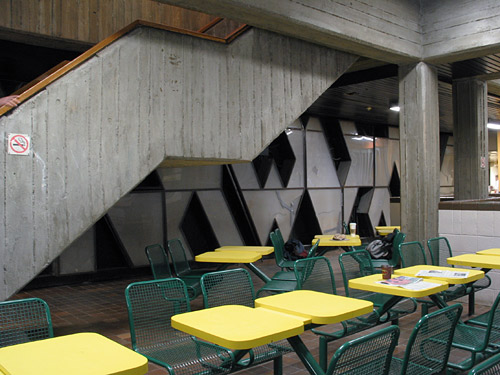|
roll your mouse over the image Interactive light sculpture by Gerald Gladstone ca 1970. This work was installed in the Carleton University unicentre on the south side of the staircase shown. As people climbed the stairs their presence was detected and lights would blink while loud clicking noises came from behind the plexi panels of the sculpture .This sculpture used incandescent bulbs and magnetic relay switches to do this. The sculpture as shown was in the process of removal (it is now gone.) I only saw this function for a brief period in the early 1970's. Given the technology that created it, it was probably doomed to a rather short lifespan. At what point does an artwork become a candidate for heritage or historical status? Technologically dependent works certainly get old much more quickly than simpler stuff. There was no plaque or indicator of its maker when I saw it. I think very few students recognized it as work of art. Some general information about these pictures: Like many other photographers, I have often made pictures of art for institutions and artists. While doing this I have learned much, made many friends and occasionally a little money. However much fun doing that kind of work is, my satisfaction from it has always been tempered by the creative limits placed on me as someone else's hired "shooter". The client always provides the subject, approves the treatment and judges its success. This
new body or work is made outside of those constraints. The pictures
are of artworks from the National Capital Region. This project has several
dimensions. I am doing this because of a my curiosity and affection for these objects and as a creative mechanism for learning and knowing. With these images I hope I can articulate some ideas and and connections that I see and put questions about living with this kind of art which is a such a defining aspect of seeing my city. As this project grows in size (- currently there are at least 125 images -) many themes and issues become easier to see and illustrate. These pictures show a wide spectrum of stuff including temporary public works, a few graffiti works, some commercial appropriations of well known artists, monuments and works that exist in the exotic territory of the contemporary fine arts milieu. . There are good, bad, neglected , expensive, forgotten , reviled, sentimental and sometimes wonderful things that suggest issues common to much of our public art in our cities. What is it for? Who paid for it? Has it lasted. Should it last? How does it work? What does it mean? And what does it mean to me? The pictures are accompanied by brief texts that tell you the name of the work, the artists, where it is and who owns/commissioned it. Sometimes, there are additional texts which discuss issues that are relevant to thinking about public art in more general terms. Any errors in fact will be corrected promptly if they are brought to my attention. I hope you like them - I will continue adding to this site for quite a long time I expect...... December 2003
|

